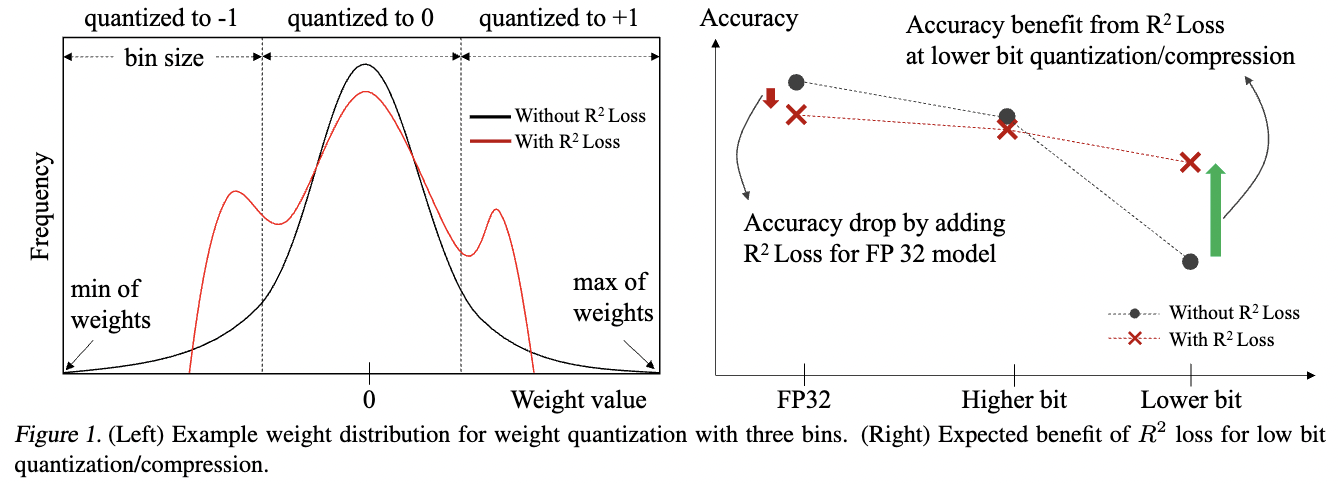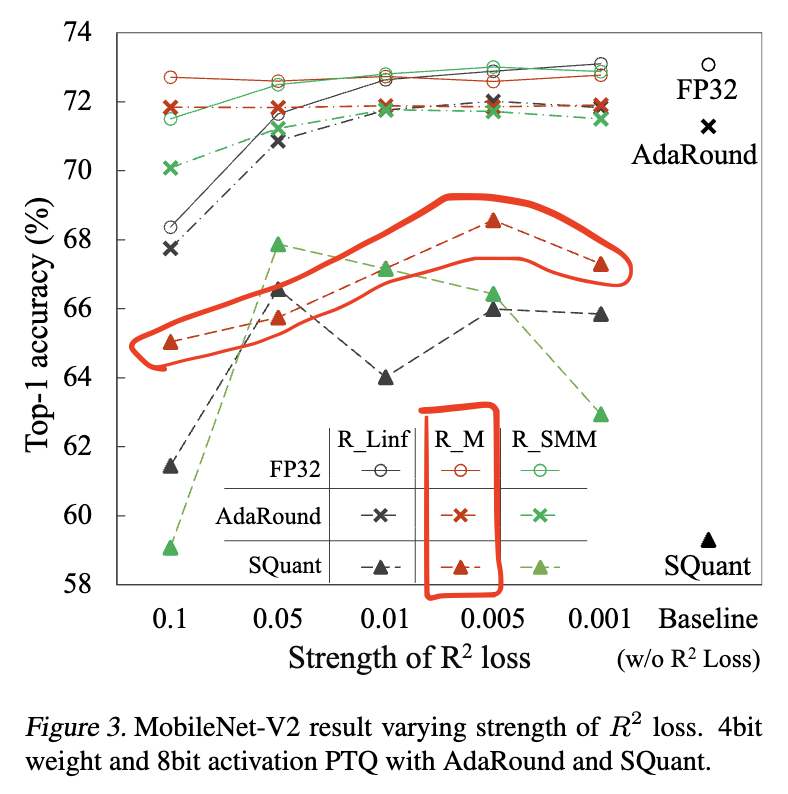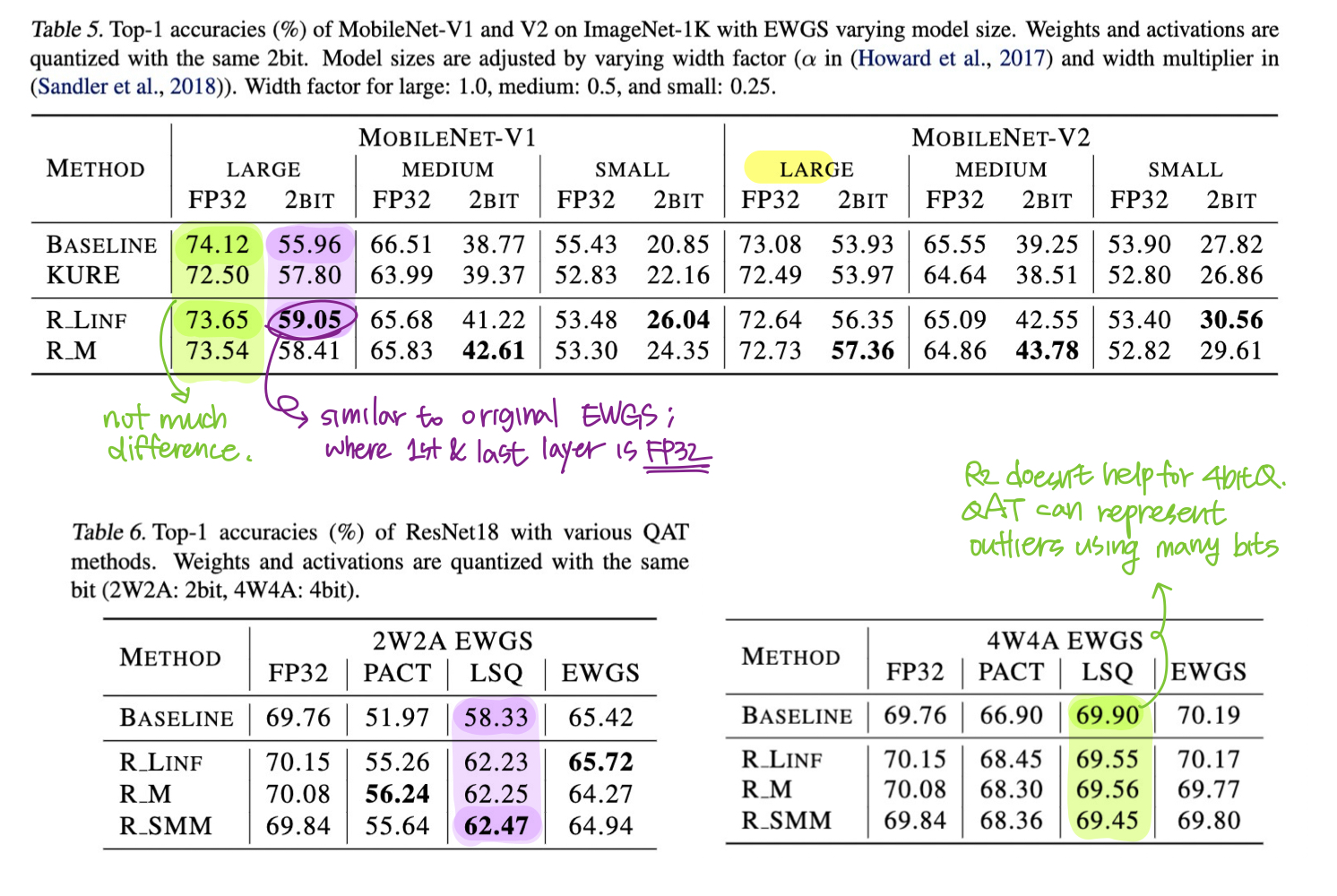R2 Loss: Range Restriction Loss for Model Compression and Quantization
2024-08-17
Keywords: #Activation #Batch Normalization
1. Introduction
- Premise: Quantization bit-resolution is inversely proportional to the range of weights and effects accuracy.
- Problem: Since outliers tend to increase range, outliers are detrimental for quantization friendly models.
- Intuitive overview of the problem & solution:

- Solution: Range Restriction Loss ($R^2$ loss)
- Regress FP32 model’s accuracy slightly as it works as additional weight regularization like weight decay.
- Quantization-friendly weight distribution removing outlier weights, so lower bit quantization accuracy can be improved.
-
Justification for R2 loss having limited benefits for higher bit quantization: SOTA also shows reasonable accuracy regression, leaving little room for improvement.
- Contributions
- R2 Loss: Simple and intuitive way to penalize outlier weights during pre-training.
- Margin R2 Loss: Penalizes weights larger than a margin, while minimizing the width of the margin.
- Soft-Min-Max R2 Loss: Smoothly penalize not only outliers but also near- outlier weights.
- R2 Loss, Margin R2 Loss → More effective to symmetric quantization.
- Soft-Min-Max R2 → More effective for others (e.g. model compression) as it makes asymmetric weight distribution.
3. Range Restriction Loss
- Goal: R2 Loss is an auxiliary loss to reduce the range of weights for every layer to get better pre-trained models for further quantization.
- Invariant to the quantization technique.
-
Reference: KURE RobustQuant
- $R^2$ loss is employed during training of the base model itself and not during quantization.
- The purpose of $R^2$ loss is to provide effective initial weights for quantization.
3.1 $L_{\infty} R^2$ loss
- Penalize only the outliers by adding $L_{\infty}(W)$ as an auxiliary loss for every layer in the model.
- Brings the overall range of weight down in contrast to KURE.
- Also makes the weight distribution similar to a mixture of Gaussians as seen in KURE.
3.2 Margin $R^2$ Loss
- Define a margin for the range of allowed weights.
- The width of the margin + Weights outside the margin is simultaneously penalize. -> Ensure that the range of the overall weight distribution is small.
- $M$ is a learnable parameter per layer.
- Difference from $R^2$ Loss: Margin $R^2$ Loss penalizes all weights outside the margin versus $R^2$ Loss penalizes only the maximum weight.
3.3 Soft-min-max $R^2$ Loss
- Eliminate the constraint on the magnitude of weights and strictly enforce it on the range of weights. → Improve asymmetrically quantized models.
- Temperature $\alpha$ is a learnable parameter per layer.
- $e^{-\alpha}$ term in the loss goes to 0 as training progresses, making $L_{reg}$ to approach hard min-max loss.
- Smooth penalization possible.
- Penalizes near-outlier weights together rather than strictly brining only outliers down like other $R^2$ losses. → More susceptible to outliers.
4. Experiment
4.1. Experiment settings
- Pre-training from scratch w/ and w/o $R^2$ Loss
- Train ResNet-18, MobileNetV1/V2 on ImageNet with R2 Loss to get pretrained models before model compression and QAT. → Compare with pre-trained models of ResNet-18 from Torchvision.
- Use modified versions of ResNet-50, -101, MobileNetV1/V2 for better FP32 performance. → Tain from scracth w/ and w/o $R^2$ Loss.
- Table 5 shows that $R^2$ loss does not significantly affect FP32 model performance.
- Model Compression and Quantization
- Apply compression and quantization for all layers including the first and last layers. (★)
- Storage benefits and performance when including and not including first and last layer quantization is shown in Table 1.

4.2. Model Quantization
- PTQ with $R^2$
- QAT with $R^2$
- PACT: Train from scratch using $R^2$ loss.
- EWGS, LSQ: Initialize model to pre-trained ResNet-18, MobileNetV1/V2 with $R^2$ loss.
4.4. Strength of $R^2$ loss & comparison between $R^2$ loss
- Strength of $R^2$: Accuracy from a model trained with Margin $R^2$ loss is more consistent and better than $L_\infty$
- Recommend to use Margin $R^2$ loss for symmetric quantization if it is hard to find proper strength for $L_\infty R^2$ loss.

5. Conclusion
- R2 Loss is a technique to get rid of outliers. → This serves as a good initialization for SOTA PTQ, QAT, and compression techniques.
- While FP32 accuracy can slightly regress as R2 Loss penalizes outliers, it significantly improves quantization accuracy for ultra low bits.
